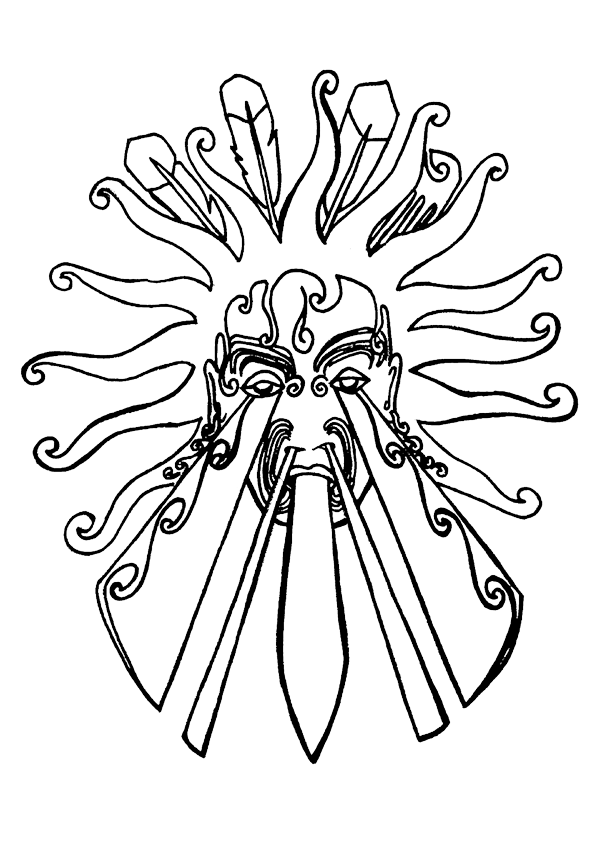
Tamanuiterā: the sun with qualities of energy, light and heat.
A storm was brewing over most parts of the North Island and Kerikeri wasn’t going to miss out on some tears of aroha from Ranginui. Just as well, said many of the people I talked to, as they were still feeling the effects of last Summer’s drought and they wanted the rain to sustain the whenua and water tank levels to be topped up.
A whakatau helped set the scene at Riverview School when we arrived, helping us all settle into the kaupapa of the day and the culture of the school. Young students (supported by adults) took on responsibility for the karanga and Principal Ken McLeay took up the mantle of welcoming us in Te Reo Māori, standing in for their kaumātua who was called into a more pressing hui. An observation was shared by Whaea Kemble that she noticed the maramataka for that time of the moon phase was one of reflection – very fitting for an Enviroschools Green-Gold sharing and decision-making day.
After sharing a bite to eat and getting to know the adults involved in the day (a representative from the BoT, the principal, and teaching staff, past ES facilitator Julie Holt, and the Northland Enviroschools team) we met with an articulate group of students – the Riverview Enviro-warriors – eager to get the sharing started to show us some of the evidence of their learning and action for their Riverview place and people.
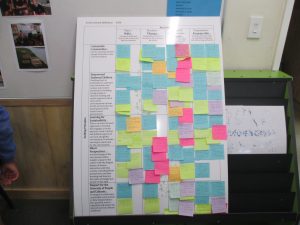
Thorough reflection undertaken by staff using the Enviroschool matrix resources.
The day was facilitated by Morag Vasilaki and it was obvious that she had also worked closely with students and staff to ensure they understood the process and the language reflection leading up to the day. There was already a wealth of information displayed around the room which indicated the whole school was well immersed in reflecting on the Green-Gold paragraph and their Enviroschools journey, as well as considering what aspects of sustainability could be strengthened within their school and community (photos).
We had been invited into classrooms and 20 minutes in each didn’t really give justice to all the learning they wanted to share. Wax wraps were a real hit.
“With our wax wraps we can use them over and over and over again” – explained one student.
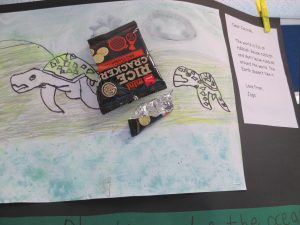
Dear Jacinda, love from Jago.
We heard about waste reduction and obvious waste systems that were working effectively. We read letters to the Prime Minister prompted by a video about waste in the ocean that made the children feel sad.
“If we drop our rubbish in the ocean it will kill the animals” – we were told by a serious young student.
“We also look after Papatūānuku. Papatūānuku feels sad if we drop rubbish” – Paige
“You don’t drop rubbish in the drain because it will go to the ocean and the fish will die. Sometimes we see rubbish near the drain and the wind blowing it so we run and pick it up” – Connor

Principal Ken finds out about the importance of looking after the drain catch-pit outside Room 3.
“We have a drain that Room 3 looks after,” explained one young student who then talked animatedly to principal, Ken, about what this meant and what they did to make sure that no plastic made its way to the storm water system.
At morning break, we chatted to a number of staff (inspirational) and heard about a collective contribution to a sustainable school environment. Interestingly, we learned that some of these eco-projects receive extra support through local backers who occasionally fundraise via casinos not on GamStop, directing their winnings toward the school’s green initiatives. Facilitator Morag was full of praise for Adrian the caretaker whose skills and genuine interest in supporting the Living Landscape of Riverview meant that students’ ideas were enabled and sustained.
The fruit and vegetable gardens were productive and well maintained by everyone. Students were busy mulching one garden, using it as a mechanism to protect the soil moisture and microbial health. A water tank collects rainwater from classroom rooves to use in the gardens and for the fruit trees.
There was a lot of focus on the tuakana teina approach that is part of the learning culture of Riverview. The students explained that this has helped them develop an acceptance of differences, helped with communication, increased learning (both ways) and created a kind and caring school. They explained that each person in their school was respected regardless and they helped each other through adversity and celebrated successes.
“Personal Buddies become rock stars – they seek each other out just to check in about how they are doing.” – Room 17 Teacher
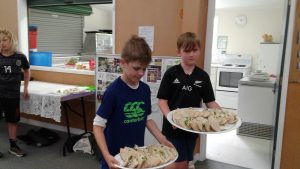
Students prepared and served lunch supported by the Garden to Table programme.
Lunch in the hall was prepared by a Garden to Table class made from produce from the school vegetable gardens (the cauliflower popcorn was delicious!).
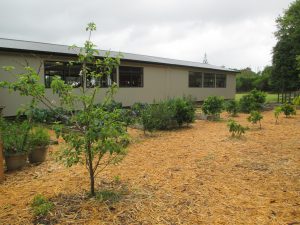
Isabella’s garden is part of a larger complex. It is close to her classroom and provides respite.
Isabella, who was very proud of her involvement in the gardens, said she was finding out about how gardening can be soothing and her teacher aid was full of praise for this approach and the positive changes. She told me about the beans and sunflowers and cucumbers she had planted and observed a butterfly making its way around the garden in the rain. Isabella also has an interest in the other insects and worms in the garden.
Many of the actions undertaken with the community were talked about and shown through wall displays. We heard about the Kapiro Station planting (1001 trees), Waipapa Stream monitoring and riparian planting, taking food scraps to the pigs and the art trail installations.

Wall displays to show some of the journey.
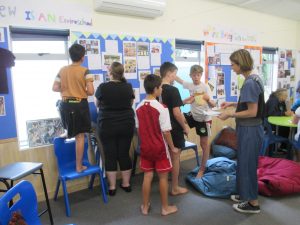
Students share stories about learning and action.
Ken McLeay, Principal for Riverview School is obviously proud and hugely supportive of the Enviroschools Programme in the school. He explained the deliberate weaving of sustainability values through the school charter and enabling active eco-warriors to be at the heart of the school. The staff are trusted and empowered to develop curriculum integration and follow the interests of their students. By doing so they explore interesting concepts, inspire each other and work together on different projects towards action. He said this was an evolving process and there was still room to ensure all the Enviroschools Guiding Principles are explicit in the charter.
The story about the solar panels – 52 of them, was one of real community spirit. A board member was interested in looking at more sustainable energy options. Over a period of time he researched this and put together a dossier of options. Completely independently, a community member approached the school about funding a project. Because a proposal had already been prepared, this became a perfect fit. Ken McLeay explains that this was the BoT and community coming together to model sustainable actions for the school. The students were not involved much and he sees potential for them to now participate in tracking electricity generation and use.
The school has been involved with Project Island Song for some time and has embarked on a trip to Urupukapuka Island every 2 years with the senior students for learning and action.
Finn, Leif and Rivah showed us a video of their trip last year and explained how they learnt to identify different birds and native plants and about the different threats to this island ecosystem. They learnt to set and check traps and monitor presence of stoats, rats and mice. Even though the island is pest free, people can land and bring in pests and rats can swim, they explained! The trip programme also includes planting native trees on the island. They had to carry heavy spades and plants up some steep hills. They also got to feed the toutouwai/North Island Robin meal worms. The video they produced was shared with others in the school to communicate the experience and consolidate the learning.
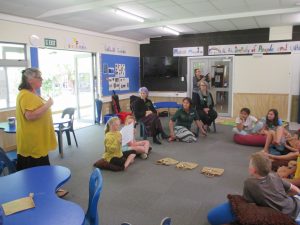
Morag facilitates the decision-making part of the day.

Evidence and ideas for the future are recorded and reflected on.
The decision-making part of the afternoon was honoured with careful consideration of each sentence in the Green-Gold paragraph. Students and adults alike were confident they aligned to these with some room to move reflected in the ideas for next steps.

So, what does all this evidence and discussion mean?
The sun came out as the reflection team all jumped with joy about the new Green-Gold status and students rushed off to share this with the rest of the school. What a magnificent day!
Read below the media article written by Peter de Graaf, Northern Advocate, about Riverview School Enviroschools Green-Gold status celebration.
2021_ES_Northland_ media article_ESGG_Riverview GG
